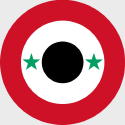Hobby Master HG3311 Syrian T-55 Main Battle Tank - Unidentified Unit, Golan Heights, 1973 (1:72 Scale)
"God willing, we shall come to a stage where the world looks at the Palestinian question, and Palestinian rights on Palestinian national soil, as well as the questions of the occupied Syrian and Lebanese territories. These are the bases on which peace will be built."
- Jordanian King Hussein I
 The T-54 and T-55 main battle tanks were the Soviet Union's replacements for the World War II era T-34 tank. The T-54/55 tank series is the most numerous in the world, and very widely employed, especially by former client states of the Soviet Union.
The T-54 and T-55 main battle tanks were the Soviet Union's replacements for the World War II era T-34 tank. The T-54/55 tank series is the most numerous in the world, and very widely employed, especially by former client states of the Soviet Union.
The T-54 and T-55 tanks are very similar and difficult to distinguish visually. Many T-54s were updated to T-55 standards. Soviet tanks were factory-overhauled every 7,000 km, and often given minor technology updates. Many states have added or modified tank equipment (India affixed fake fume extractors to its T-54s and T-55s, so that Indian gunners wouldn't confuse them with Pakistani Type 59s).
The T-54 can be distinguished by a dome-shaped ventilator on the turret front-right, and has a SGMT 7.62 mm machine gun in a fixed mount in the front of the hull, operated by the driver. Early T-54s lacked a gun fume extractor, had an undercut at the turret rear, and a distinctive "pig-snout" gun mantlet. The T-55's new turret has large D-shaped roof panels, visible from above.
Pictured here is a 1:72 scale replica of a Russian-built T-55 main battle tank employed by the Syrian Army as they attacked the Israeli-held Golan Heights in 1973.
Sold Out!
Dimensions:
Length: 4-inches
Width: 1-1/2-inches
Release Date: June 2009
Historical Account: "Armed Camps" - In the Golan Heights, the Syrians attacked two Israeli brigades and eleven artillery batteries with five divisions (the 7th, 9th and 5th, with the 1st and 3rd in reserve) and 188 batteries. They began their attack with an airstrike by about 100 aircraft and a 50-minute artillery barrage. The forward brigades of three divisions then penetrated the cease-fire lines and bypassed United Nations observer posts, followed by the main assault force, which was covered by mobile anti-aircraft batteries, bulldozers to penetrate anti-tank ditches, bridge-layers to overcome obstacles and mine-clearance vehicles. The engineering vehicles were priority targets for Israeli gunners and took heavy losses, but Syrian infantrymen, braving intense fire, advanced forward and used their entrenching tools to build up earthen causeways for the tanks, enabling them to overcome anti-tank ditches.
At the onset of the battle, the Israeli brigades of some 3,000 troops, 180 tanks and 60 artillery pieces faced off against three infantry divisions with large armour components comprising 28,000 Syrian troops, 800 tanks and 600 artillery pieces. In addition, the Syrians deployed two armoured divisions from the second day onwards. Every Israeli tank deployed on the Golan Heights was engaged during the initial attacks. Syrian commandos dropped by helicopter also took the most important Israeli stronghold at Mount Hermon, which had a variety of surveillance equipment. An Israeli force attempting to counterattack was stopped by a Syrian ambush.
The Golan Heights front was given priority by the Israeli High Command because of its proximity to Israeli population centers. If the Syrians had regained the area, it would pose a serious threat to major Israeli cities such as Tiberias, Safed, Haifa and Netanya.
Reservists were directed to the Golan as quickly as possible. They were assigned to tanks and sent to the front as soon as they arrived at army depots, without waiting for the crews they trained with to arrive, machine guns to be installed on the tanks, or taking the time to calibrate the tank guns (a time-consuming process known as bore-sighting). The Syrians had expected it to take at least 24 hours for Israeli reserves to reach the front lines; in fact, reserve units began reaching the battle lines only 15 hours after the war began. Israeli reserve forces approaching the Golan Heights were subjected to Syrian artillery fire directed from Mount Hermon.


